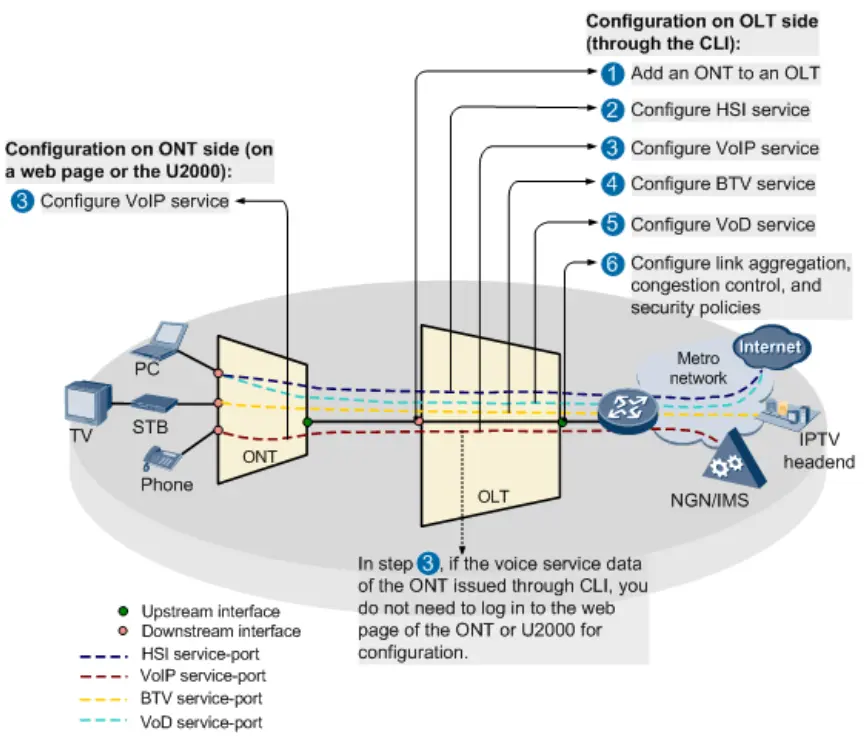Hello, everyone!
Recently, MA5608T is very popular. Many friends want to know all about it.
During this period, I have sorted out the contents of the MA5608T for you. Please click the contents that you are interested in to display them in detail.
To make it easier for new friends to get to know it, let’s first take a look at it: MA5600T/MA5603T/MA5608T series products
Of course, we will also introduce more details about the MA5608T: MA5608T parameters information
Next, let’s introduce the configuration of the MA5608T.
How to configure Internet access service, voice service, BTV service and VoD service when bridging + voice ONTs are used to build an FTTH network.
(The FTTH GPON and 10G GPON access have the same configuration procedure. ONT web pages for configuring them have differences; however, they have the same configuration parameters. The following uses GPON ONT configuration as an example. For differences on web pages, see the related ONT manuals.)
Configuration Process
Configuration roadmap in FTTH networking using a bridging+voice ONT.
| Item | Step | Description | |
| Optical
line terminal (OLT) |
Adding an ONT to an OLT | Services can be configured for an ONT only after the ONT is successfully added to an OLT. | |
| OLT | Configuring the Internet Access Service | None | |
| OLT
ONT U2000 |
Configure the VoIP service | Configuring the H.248-based Voice Service (on a Web Page or the U2000) | NOTE:
1. The H.248 and Session Initiation Protocol (SIP) protocols are mutually exclusive for the VoIP service. Either of them is configured at a time. 2. The voice service can be configured through a command-line interface (CLI) on an OLT, web page, or U2000. Select a configuration mode based on-site requirements. 1) OLT CLI: This mode can be used for site deployment or the U2000 has not been deployed. 2) Web page: This mode can be used to configure voice parameters after the service channel has been configured through the OLT CLI. It can be used for site deployment. 3) U2000: This mode can be used to configure voice parameters after the service channel has been configured through the OLT CLI. It can be used for service provisioning in batches. |
| Configuring the H.248-based Voice Service (Through the CLI) | |||
| Configuring the SIP-based Voice Service
(on a Web Page or the U2000) |
|||
| Configuring the SIP-based Voice Service
(Through the CLI) |
|||
| OLT | Configure the IPTV service | Configuring the BTV
Service |
IPTV services include the BTV and VoD services that are different in configuration procedures and need to be configured separately. |
| Configuring the VoD
Service |
|||
| OLT | Configuring Link Aggregation, Congestion Control,
and Security Policies |
The global configuration of link aggregation and queue scheduling based on priorities ensures service reliability. The global configuration of security policies ensures service security. | |
| OLT | Verifying Services | The OLT provides remote verification methods including ONT PPPoE/DHCP dialup emulation and call emulation for configuration and commissioning engineers to verify services remotely after service configuration, avoiding a second on-site operation. | |
The following table describes the configuration steps.
Service Requirements
Optical fibers are connected to users’ home and triple play services are required. The following provides detailed service requirements:
1. Internet access of multiple PCs in a home is supported.
2. Access of multiple telephones in a home is supported.
3. IPTV programs can be previewed and watched using STBs.
4. Service expansibility is supported and different services do not affect each other.
5. Proper service security is ensured.
a. Internet access services are protected against unauthorized access, user account theft or borrowing, MAC/IP spoofing, and malicious attacks.
b. Voice and IPTV services are protected against MAC/IP spoofing, malicious attack, and traffic flooding attacks.
6. Service faults are easy to locate and services are easy to maintain.
Application Scenario
See the following figure., the ONT integrating an integrated access device (IAD) provides Internet, VoIP, and IPTV services to users.
The bridging+voice ONT provides Layer 2 data (Internet and IPTV services) and VoIP services. This scenario provides transparent transmission channels and requires simple service configuration, so this scenario applies to Layer 2 networking.
1. For Internet services, a PC directly performs dial-up. Then, the upper-layer broadband remote access server (BRAS) device authenticates and accesses the PC. The PC can also access the Internet using the Dynamic Host Configuration Protocol (DHCP) or static IP address.
2. For VoIP services, the ONT with a built-in voice module encapsulates voice service packets, and the OLT transmits them to the upstream next-generation network (NGN) or IP multimedia subsystem (IMS).
3. For IPTV services, the set-top box (STB) obtains an IP address from the DHCP server for ordering programs. The ONT transparently transmits the packets.
The preceding information in red is a link. Please read it patiently. This is a learning process.
All the above information about the MA5608T is available. If you have any questions or suggestions, please communicate at the bottom of the forum.
Thank you very much for reading!


Leave a comment